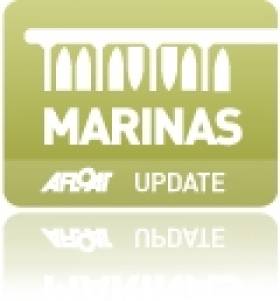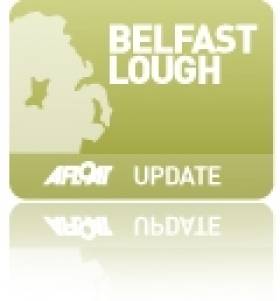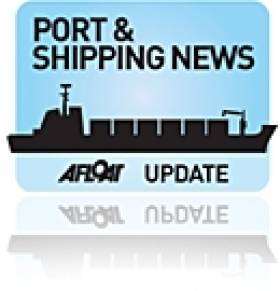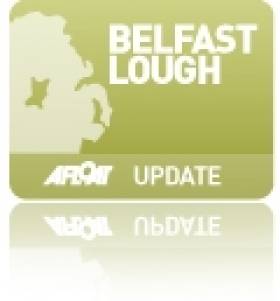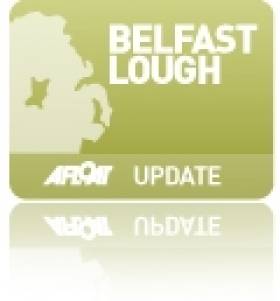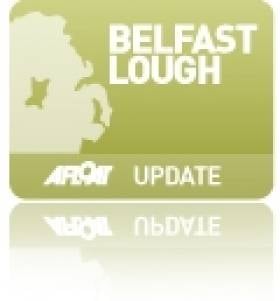Displaying items by tag: Belfast Harbour
Belfast Harbour's leisure craft facilities are situated at the head of Belfast Lough within a 10 minute walk of the City centre. The current 40 berth facility is a forerunner to a new fully equipped 200 berth marina located in the heart of Belfast's Titanic Quarter.
The present facility, located in Abercorn Basin was installed to host the Belfast Tall Ships Festival in August 2009 and was funded by the Northern Ireland Tourist Board and Belfast Tall Ships 2009 Ltd.
The harbour authoriy has installed 240m of pontoons and dredged the Basin to a depth of 4m.
The marina can handle vessels up to 35m LOA, maximum draught of 4.0m.
Vessels greater than 20m should contact Port Operations prior to arrival.
Any enquiries regarding berth availability should be made to the Port Operations Centre by emailing [email protected] or telephoning +44(0)28 9055 3015 during office hours.
DFDS to Shed 60 Jobs in Belfast Operation
#DFDSBelfast – Shipping and logistics company DFDS are to let go 60 jobs in Belfast at the end of this year as it shifts its finance centre to Poland.
Danish owned company DFDS said Belfast would be the first location to lose its finance department out of the 21 countries in which it operates.
The office on West Bank Road in Belfast will close in December, DFDS said. However its other Irish operations, including DFDS Logistics in Belfast and Dublin, are not affected.
For more on this story the Belfast Telegraph reports.
#CruiseBELFAST – Opening the cruiseship season to Belfast Harbour today is the small ultra-luxury Hebridean Princess, now serving her 25th year of operations, writes Jehan Ashmore.
The former west Scottish isles car-ferry Columba currently operated by Hebridean Island Cruises, is the first of 60 cruise callers to bring 100,000 visitors to the city port during 2013.
Belfast Harbour can also look forward later this month in officially marking its 400th anniversary when the port's first quay was established by a Royal Charter in 1613.
On a related royal note, Hebridean Princess was chartered by Queen Elizabeth II for a family holiday cruise around the Scottish isles to mark her 80th birthday in 2006.
The ship is berthed in Pollock Dock (see basin on left of aerial view) which is situated closer to the city-centre compared to the Stormont Wharf facility which caters for considerably larger cruiseships.
As previously reported on Afloat.ie, 2013 is set to become another breaking season, in contrast to last year's season when 44 cruiseships called carrying 75,000 passengers.
Among the cruise operators to call they include Princess Cruises, Holland America Line, Celebrity, MSC, Thomson, Fred Olsen Cruise Line and Saga Cruises. For details of calls click the LINER-LIST.
Belfast Harbour’s Tonnage Record in 2012
#BelfastHarbour – Figures released by Belfast Harbour reveal that trade handled by the port during 2012 rose to a record 19.6m tonnes, up 11% on the previous year. The growth was driven primarily by an improved performance in the bulk and roll-on / roll-off (freight vehicle) sectors.
A record 4.6 million tonnes of dry-bulk was handled, a jump of 16%. This included 2m tonnes of grain and animal feeds, the highest tonnages ever recorded by the harbour in this sector.
An additional 600,000 tonnes of coal was also handled, reflecting recent investments by the harbour in deep-water facilities which have enabled it to handle coal imports for AES's power station at Kilroot, on the northern coast of Belfast Lough. Coal imports are now in excess of 1m tonnes for the first time since 1996.
Major investments by Belfast Harbour and Stena Line in new terminals on both sides of the Irish Sea, plus a pair of new superfast ferries, have significantly enhanced the competitiveness of the Belfast – Cairnryan route.
Port Tonnages Rise by 11%
This, coupled with a record performance on the Belfast – Heysham route, helped drive the number of freight vehicles passing through the Port to 432,000, up 21% since 2011.
Commenting on the figures, Roy Adair, Belfast Harbour's CEO, commented: "It's greatly encouraging for Belfast Harbour to once again be able to report such a positive set of trade figures. Growth across a number of sectors reaffirms Belfast's position as one of the most efficient ports in these islands and helps benchmark the harbour's ongoing contribution to the Northern Ireland economy.
"Long-term investments by the harbour and by key port users such as Stena Line have delivered significant benefits to the regional economy. It is particularly pleasing that the roll-on / roll-off traffic has performed so strongly in what is one of the most competitive sectors in the port industry. "
Liquid Bulk total imports in 2012 remained steady compared with the previous year, with 2.1 million tonnes handled. Container traffic fell back by 5% to 123,000 boxes as consumer demand continued to soften. Construction related trades such as timber also continued to decline. Timber imports fell for the seventh year in a row, down by 9%.
On a more positive note, there was some indication of a recovery in activity in Northern Ireland's manufacturing base with steel imports rising by 11% to 128,000 tonnes, the highest level since 2008.
Passenger numbers using the port's ferry services also increased by 11% to almost 1.4 million, reflecting the growing popularity of 'holidays at home' and major boosts to Northern Ireland's tourist sector with the opening of Titanic Belfast and the new Giant's Causeway visitor centre. The 'Titanic' effect was even more evident in the cruise sector with 45 ships and 75,000 visitors calling at Belfast in 2012 – a rise of 40% since 2011.
Joe O'Neill, Belfast Harbour's Commercial Director added: "While the overall trend in tonnages handled is positive, the harbour is ever mindful that the wider economic outlook remains challenging. The record level of trade handled in 2012 was a direct consequence of a major investment programme; similar investments will be required for the long-term competitiveness of the port.
"For example, the trend for ever larger vessels plus Belfast's growing popularity as a cruiseship destination – bookings for 2013 are already up by over 25% - will require further investments in the port's deep water facilities to accommodate demand.
"Belfast Harbour will also continue to pursue major marine projects such as the development of a £50m, 50-acre offshore wind farm terminal for DONG Energy."
Belfast Harbour Launch Masterplan
#BELFAST PORT – Plans for the future of Belfast Harbour has been outlined for the next 20-30 years with the publication of a Masterplan.
Interested parties are invited to download the document from the port's website. Those parties wishing to offer commentary on the plans are asked to follow the response instructions at the end of the document and provide comments before 7 December 2012.
An improved performance in both turnover and profits were recorded during 2010-2011. According to the harbour's annual report a 2% rise was achieved in profit before taxation to £17.8m and a 4% increase in turnover totalled £36.1m
Ports & Shipping Review: Cruising to the Sun, WWI Warship’s Tourist Role, Stena’s 50th Year, Cargoship Record, Dock Survey of Lighthouse tender and more…
#PORTS & SHIPPING REVIEW - Over the last fortnight Jehan Ashmore has reported from the shipping scene where Irish passengers left wintery conditions by embarking on a cruise directly from Dublin Port which was bound for sunnier climes in Iberia and the Atlantic isles.
A multi-cat workboat, Island Kestral was acquired by Wicklow based Island Shipping, the vessel will be chartered to offshore projects including the renewables industry sector.
Following the fate of the WW1 Battle of Jutland cruiser HMS Caroline, which is to remain in Belfast, the 98-year vessel is to be made into a tourist visitor attraction, likewise of London's HMS Belfast, another veteran but from WW2.
Those considering a career at sea, should take note that the National Maritime College of Ireland (NMCI) is to host a 'Open' Day next Tuesday (23 October) at the campus based in Ringaskiddy.
What's in a name...Stena Line, a household name, but did you realise that the Swedish owned ferry giant derives its name from founder Sten A. Ollsen, and this year celebrates its 50th anniversary. How did the company become to where it is today, operating 19 routes which includes Dun Laoghaire-Holyhead, served by the HSS Stena Explorer, which is to return to the route for 12 days during the festive and new year periods.
While Irish Sea rivals, Irish Ferries is to add a third ferry on to the Dublin Port-Holyhead route also to cover for the festive and new year sailings. The unprecedented transfer of the Isle of Inishmore will join the route's existing tonnage, Ulysses and fast-ferry Jonathan Swift, to provide additional capacity during the busy season.
Those with a strong interest in liners, should head for the London Ship Show next Saturday (27 October). Among the exhibitors are maritime booksellers, artists, model-makers, traders in memorabilia and ephemera postcards. There will be talks about P&O Cruises 175th anniversary 'Grand Event' in the Solent which featured the Arcadia that sailed to Dublin.
A major international conference on Ocean Energy was held in Dublin's Convention Centre and facing opposite the venue, a scientific weather buoy was positioned on the Liffey.
Passengers travelling on ferry routes will be able to have the same travel rights given to those flying or taking the train, when the National Roads Authority is to implement on 18 December.
A record breaking single cargo shipment of 56,000 tonnes of coal, was set in Belfast Harbour, when the bulk-carrier Ocean Breeze docked in the port having sailed from Virginia in the U.S.
Irish Rail which operates Rosslare Europort is to undergo a strategic review, which is predominantly served by the ferry sector, could be transferred to potentially different ownership.
Today the tallship Tenacious is having an 'Open' Day, where the public can board the 65m barque berthed at Sir John Rogersons Quay in Dublins Docklands between 10.00am-12.30pm and 2-4pm.
The hard-working lighthouse tender ILV Granuaile is undergoing a docking survey in Cork Dockyard. The vessel was built in Galati on the River Danube, Romania for the Commissioners of Irish Lights whose headquarters are in Dun Laoghaire, which is the vessel's homeport.
AGM of Belfast Harbour
#PORT AGM – The annual general meeting of Belfast Harbour is to take place at the Harbour Office, Corporation Square, during the morning of 23 October between 09.45 -10.45.
As previously reported, Belfast Harbour recently unloaded its single largest ever cargo shipment of 56,000 tonnes of coal, which broke all records to date, over the ports 400 year long history.
According to the port, around 60% of the north's seabourne trade and 20% of the entire island's is handled at the harbour, handling around 17m tonnes of cargo per annum and where approximately 5,500 vessels call each year.
Belfast Lough Deepened for Record Breaking 'Cargo' Ship
#BELFAST LOUGH- The record for the largest single cargo shipment to Belfast Harbour over its 400-year history was broken last Saturday, reports The Belfast Telegraph.
The record was set by the bulk carrier 'Royal Breeze' which was laden with 56,000 tons of coal, having sailed across the Atlantic from Virginia. The vessels mammoth tonnage dwarves the previous largest cargo to arrive at the port of 41,000 tons and follows the deepening of Victoria Channel in Belfast Lough to cater for such large vessels.
The coal is destined for AES UK's Kilroot power station and was unloaded by the harbour's newest crane, the £2.8m, 40m Gottwald - the largest crane in use in any UK or Irish port.
Belfast Harbour Notice: Changes to Navigation and Traffic Aids
#BELFAST HARBOUR - Mariners using Belfast Harbour are advised of a number of changes made to buoys placed in Belfast Lough to aid in navigation and traffic management.
The existing Fairway Buoy has been moved east northeast (ENE) to a new position, while four new buoys have been added - two at the main approach to the Port of Belfast, and two further out in the lough at Kilroot and Helen's Bay.
Vessels heading into the Port of Belfast are to pass north of the repositioned Fairway Buoy, while outward vessels must now pass south of the buoy, both reporting to Belfast Harbour Radio on VHF Channel 12.
Moreover, all vessels arriving to and departing from Belfast Harbour, when proceeding to or from anchorages or other berths within Belfast Lough, are requested to make contact with Belfast Harbour Radio to confirm their passage plans whether inbound (15 minutes from the Fairway), outbound (on passing Beacon No 12) or on heaving anchor.
Full details of co-ordinates of the new buoy placements are included in Belfast Harbour Notice No 20 of 2012, a PDF of which is available to read or download HERE.
Belfast Harbour Gets New Wind Turbine Building Hub
#BELFAST LOUGH NEWS - A new hub for wind turbine manufacturing at Belfast Harbour is expected to the completed by the end of this year, as the Belfast Telegraph reports.
The 50-acre reclaimed site on the shores of Belfast Lough chosen by Danish energy company DONG has apparently been kept vacant or more than 50 years awaiting the right development.
When operational early next year, the new 'offshore wind logistics terminal' - which will produce wind turblines for the West of Duddon Sands Wind Farm in the Irish Sea off Cumbria in north-west England - is expected to create 300 jobs in the growing renewable energy sector. Meanwhile, 150 workers will be needed for the construction phase.
A spokesperson for Belfast Harbour described the £50 million (€63.2 million) project as "the largest ever in Belfast Harbour's 400-year history" and "a major vote of confidence" in the harbour's long-term investment strategy.
The Belfast Telegraph has more on the story HERE.


























